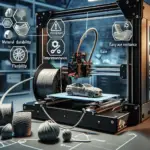
- arrow_back Home
- keyboard_arrow_right 3D Printers
Understanding the Resin (SLA) Printing Process

3D PrintersSLA - Resin Chris Wyatt 7 June 2024
Introduction to Resin Printing
What is Resin Printing?
Resin printing is a type of 3D printing that uses photopolymer resins cured by a light source to create intricate and highly detailed objects. Unlike traditional filament-based 3D printing, resin printing is known for its superior surface finish and ability to produce complex geometries. This method is particularly popular in industries requiring precision and detail, such as jewelry, dental, and miniature model making.
History and Evolution of Resin Printing
The history of resin printing dates back to the 1980s with the invention of stereolithography (SLA) by Chuck Hull. Over the years, the technology has evolved significantly, with advancements in light sources, resin formulations, and printer mechanics. Today, various types of resin printers, including SLA, DLP, and LCD, offer improved speed, accuracy, and user-friendliness, making resin printing accessible to both professionals and hobbyists.
Types of Resin Printers

SLA (Stereolithography) Printers
SLA printers use a laser to cure liquid resin layer by layer, creating highly detailed and smooth objects. These printers are known for their precision and are commonly used in applications requiring fine details, such as dental models and jewelry. SLA printers tend to be more expensive but offer superior print quality compared to other types of resin printers.
DLP (Digital Light Processing) Printers
DLP printers use a digital light projector to cure resin, allowing for faster print times and high-resolution outputs. These printers are ideal for producing small to medium-sized objects with intricate details. DLP technology is often used in industries like dental prosthetics and custom jewelry due to its ability to produce consistent and accurate results.
Materials Used in Resin Printing
Types of Resins
There are several types of resins used in resin printing, including standard resins, flexible resins, tough resins, and castable resins. Each type has unique properties that make it suitable for specific applications. For instance, flexible resins are used for creating bendable objects, while castable resins are ideal for making molds for metal casting in jewelry making.
Properties of Different Resins
Different resins offer varying properties such as hardness, flexibility, and durability. Standard resins are typically rigid and brittle, while tough resins offer higher impact resistance. Flexible resins can bend without breaking, and castable resins burn out cleanly, leaving no residue. Understanding these properties is crucial for selecting the right resin for a specific project or application.
The Resin Printing Process

Preparing the 3D Model
Preparation of the 3D model is the first step in the resin printing process. This involves designing or downloading a 3D model file, which is then sliced into layers using slicing software. The software also allows for the addition of supports to ensure the model prints correctly. Proper model preparation is essential for achieving high-quality prints with minimal errors.
Setting Up the Printer
Setting up the printer involves several steps, including leveling the build platform, filling the resin vat, and loading the prepared 3D model file. It’s important to calibrate the printer settings according to the type of resin being used. Ensuring the printer is correctly set up helps in achieving precise and accurate prints, reducing the likelihood of print failures.
Troubleshooting Common Issues
Print Failures
Print failures can occur due to various reasons such as improper leveling, incorrect exposure settings, or insufficient support structures. Identifying the root cause of a print failure is crucial for resolving the issue and achieving successful prints. Regular maintenance and careful setup can minimize the chances of encountering print failures.
Surface Imperfections
Surface imperfections like layer lines, rough textures, and resin residue can affect the final appearance of printed models. These issues can often be resolved by adjusting printer settings, such as exposure time and layer height. Post-processing techniques like sanding and polishing can also improve the surface finish of the printed objects.
Tips and Best Practices

Optimizing Print Quality
Optimizing print quality involves fine-tuning printer settings, using high-quality resins, and ensuring proper model preparation. Regular cleaning and maintenance of the printer can also contribute to better print results. Additionally, experimenting with different layer heights and exposure times can help in achieving the desired level of detail and surface finish.
Efficient Use of Resin
Efficient use of resin can be achieved by planning and arranging multiple objects on the build platform to maximize the print area. Using supports sparingly and optimizing the orientation of the model can also reduce resin consumption. Proper storage and handling of resin ensure its longevity and minimize waste, leading to cost-effective printing.
Future of Resin Printing
Technological Advancements
The future of resin printing looks promising with continuous technological advancements. Innovations in light sources, resin formulations, and printer mechanics are expected to improve print speed, accuracy, and material properties. These advancements will expand the applications of resin printing, making it more versatile and accessible to a wider audience.
Emerging Applications
Emerging applications of resin printing include medical device manufacturing, custom prosthetics, and advanced engineering prototypes. The ability to produce highly detailed and precise objects makes resin printing ideal for these applications. As technology continues to evolve, new uses for resin printing are likely to emerge, further revolutionizing various industries.
About Ultimate 3D
Learn everything there is to know about 3D Printers and the different components and printing materials.
Site Links
Copyright 2024 Ultimate 3D





Be the first to leave a comment